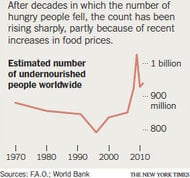There was a very important bit of reporting in the NY Times yesterday: A Warming Planet Struggles to Feed Itself. Among the most important things it does is illustrate quite clearly how the extremes of temperature and precipitation that are becoming the norm are negatively affecting agricultural production. Productivity losses generate higher prices which, in turn, means people at the wrong end of the economic spectrum lose their fragile ability to feed themselves and their families.
Weather anomalies like the heatwave and the fires that plagued Russia and the Ukraine last summer, the drought that is crushing China and Texas now and has been persistent in Australia, the floods in Pakistan last year and in the US this year – all of these disrupt farming, producing huge shortfalls.
The article also partially debunks the notion that higher carbon dioxide levels will promote greater crop growth. It turns out that that phenomenon is not anything near what it has been cracked up to be, and, in any event, is rather quickly offset by higher temperatures.
What is critical in our changing climate is to find ways of adapting agriculture. One approach that the article celebrates is the hybridization of new crops: rice, for instance, that can withstand much more water than normal rice for the wetter conditions and flooding that are inevitable in many rice-growing regions.
However, we are only informed in passing that the pressures from much more demand for meat and from biofuel production are also contributing factors to the higher food prices. I applauded Paul Krugman this past winter when he wrote about “Droughts, Floods and Food” but I also wondered why he didn’t ask the question: Why do we simply accept the fact that demand for meat is going to rise? The FAO had a comprehensive look a few years back on Livestock’s Long Shadow.
Krugman has also written eloquently on the effect of biofuel production on food prices. It is misguided to think that we can produce the food we need, at prices that are affordable, while we squander prime agricultural land – and massive quantities of precious water – on cattle and pigs for meat, feed for them, and biofuels. Most of the world’s rainforests that have been decimated have been cut down for grazing, cultivation of soybeans for feed, and palm oil for biofuel. Plus – don’t shoot the messenger – there’s the incredible burden of pollution, not to mention cost, from fertilizers and pesticides. (The same reporter, Justin Gillis, who’s written the climate and agriculture piece, has also contributed further insights on the pernicious problems of pollution from industrial agriculture and forest degradation.)
For more on food security, see the sister blog to this at Global Food Security.
